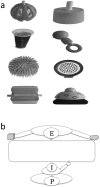Infants learn what they want to learn: responding to infant pointing leads to superior learning
- PMID: 25290444
- PMCID: PMC4188542
- DOI: 10.1371/journal.pone.0108817
Infants learn what they want to learn: responding to infant pointing leads to superior learning
Abstract
The majority of current developmental models prioritise a pedagogical approach to knowledge acquisition in infancy, in which infants play a relatively passive role as recipients of information. In view of recent evidence, demonstrating that infants use pointing to express interest and solicit information from adults, we set out to test whether giving the child the leading role in deciding what information to receive leads to better learning. Sixteen-month-olds were introduced to pairs of novel objects and, once they had pointed to an object, were shown a function for either the object they had chosen, or the object they had ignored. Ten minutes later, infants replicated the functions of chosen objects significantly more than those of un-chosen objects, despite having been equally visually attentive during demonstrations on both types of objects. These results show that offering information in response to infants' communicative gestures leads to superior learning (Experiment 1) and that this difference in performance is due to learning being facilitated when infants' pointing was responded to, not hindered when their pointing was ignored (Experiment 2), highlighting the importance of infants' own active engagement in acquiring information.
Conflict of interest statement
Figures
References
-
- Csibra G, Gergely G (2009) Natural Pedagogy. Trends Cogn Sci 13(4): 148–153. - PubMed
-
- Csibra G (2010) Recognising communicative intentions in infancy. Mind Lang 25(2): 141–168.
-
- Horner VK, Whiten A (2005) Causal knowledge and imitation/emulation switching in chimpanzees (Pan troglodytes) and children. Anim Cogn 8: 164–181. - PubMed
MeSH terms
Grants and funding
LinkOut - more resources
Full Text Sources
Other Literature Sources


